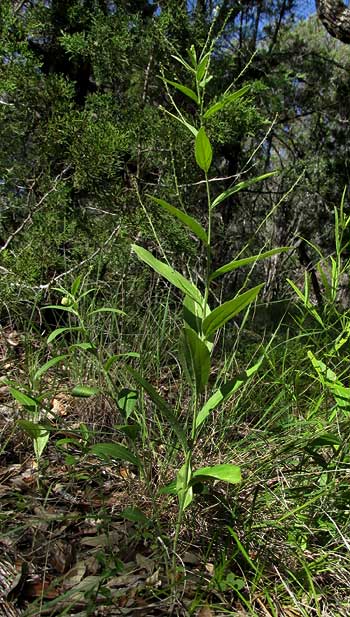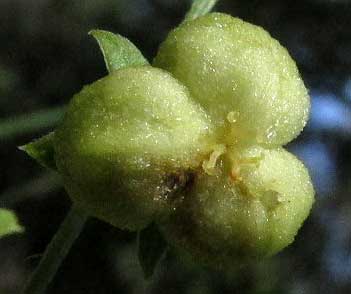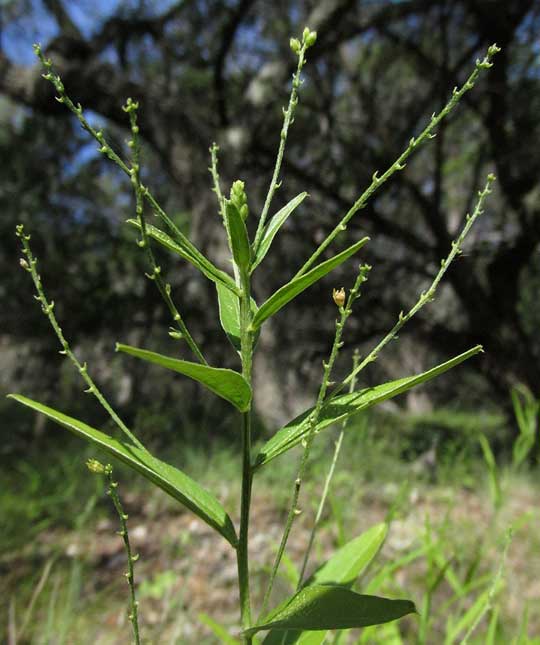Excerpts from Jim Conrad's
Naturalist Newsletter
from the September 14, 2014 Newsletter issued from the Frio Canyon Nature Education Center in the valley of the Dry Frio River in northern Uvalde County, southwestern Texas, on the southern border of the Edwards Plateau; elevation ~1750m (~5750 ft); N29.62°, W99.86°; USA
PLATEAU SILVERBUSH
Lately we've been encountering interesting members of the Spurge or Euphorbia Family, the Euphorbiaceae. That's not too surprising, since the Spurge Family is big, holding about 7500 mostly tropical, mostly American species, and generally members of the family produce small, greenish, easy-to-overlook flowers. Last year I probably walked right past them, with my out for gaudier fare. This week's knee-high, unspectacular but interesting attraction, growing in rocky soil on a slope in a limestone area, is shown below.

With one leaf per stem node (alternate arrangement) and the leaves with no lobes, no teeth on the margins, no hairiness -- at first glance this plant couldn't be more nondescript. However, notice the very slender items arising from the angles between the upper leaf bases and the stem -- the "upper leaf axils." Those are flowering, spike-like racemes, and clearly any flowers there are very small. However, notice on the left side of the picture a second, shorter stem leaning toward the image's border. At the very tip of that stem there's a pea-sized, roundish, greenish thing. Below, a close-up shows what it is:

That's a three-lobed fruit, and the moment it came in view I knew we had another member of the Spurge Family. Flowers and fruits of most dicot wildflowers have their parts in 4s, 5s, or multiples thereof, but the big Spurge Family does things in 3s. Three-parted fruits are common among monocot-type wildflowers, such as lilies and orchids, but not dicot ones. A view of our three-lobed fruit from the front, showing a greenish, forked stigma arising at the top where the parts come together is shown below:

Members of the Spurge Family -- "euphorbs," as botanists refer to them -- produce unisexual flowers, either at separate places on the same plant (monoecious), or on different plants (dioecious). Our plant is monoecious. Those slender items seen earlier at the top of the plant were racemes of male flowers from which most flowers had fallen after their pollen had been released. Below, you can see the racemes with a few male flowers still attached:

A leaf with three major veins arising at its base and a male-flower raceme emerging from the leaf axis is shown below:

When keying out the genus, these field marks are noted:
These and other features lead us to the genus Argythamnia, which in the old days was called a more memorable Ditaxis. Members of the genus are commonly known as silverbushes.
Four Argythamnia species occur in Texas, and this one separates from the others easily with its long, slender racemes of male flowers overtopping the leaves below them by a long shot. It's the Plateau Silverbush, sometimes also called Tall Wild-mercury; it's ARGYTHAMNIA SIMULANS*.
The "Plateau" in the first name alludes to the fact that in the whole world the plant occurs only in Texas, mostly in the south-central part of the state known as the Edwards Plateau. We're on the Pleateau's southern slope.
Since it's so uncommonly encountered, not much is known about the Plateau Silverbush. I'm tickled to provide what little information we have on it here.